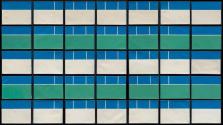Advanced Search
Blue, White, Green
Ralph Coburn (American, 1923–2018)
about 1950
Medium/Technique
Oil on canvas
Dimensions
Height x width (assembled): 40 1/2 x 84 in. (102.9 x 213.4 cm)
Credit Line
Museum purchase with funds by exchange from the Bequest of Dora N. Spalding, Gift of Alfred I. du Pont, Bequest of Sarah Wyman Whitman, Gift of Mr. Waldo Pierce, and Gift of Mrs. George F. Munn
Accession Number2008.39.1-35
NOT ON VIEW
CollectionsAmericas
ClassificationsPaintings
Coburn's brief two years in the architectural program at Massachusetts Institute of Technology from 1941 to 1943 has informed his artistic output throughout his career, giving his work a distinct sense of disciplined design and carefully orchestrated color relationships. After serving in the Air Force during World War II, Coburn returned to Boston in 1945 and began to work at the Mirski Gallery where he also studied painting. In 1949 he went to Paris, making the first of four trips. There he joined other Boston-trained artists, including his lifelong friend Ellsworth Kelly [1987.419]. The two traveled and worked together, discovering traditional and modern art and architecture in museums, galleries, and monuments. They studied avant-garde styles, especially Surrealism, and visited Hans (Jean) Arp, one of the movement's major figures [see 64.1474; 65.934; 2002.184, for example]. Both Coburn and Kelly were fascinated with Arp's experiments with the role of the unconscious in creating a work of art, and both subsequently explored automatic drawing or drawing by chance in which the artist approaches a blank piece of paper with no preconceived idea of what to draw and allows the composition to unfold spontaneously.
Back in Boston, Coburn applied the concept of chance to the arrangement of Blue, White, Green. He painted thirty-five canvases in eight different geometric compositions, restricting his palette to the three colors of the title. According to the artist, he conceived of the layout of the canvases in seven vertical metal frames, each holding five units, as seen here and as exhibited in 1950 at the Mirski Gallery. Once the composition was out of his hands, however, he felt that the individual paintings could be displayed in any sequence, ordered or random, in what he called "arrangement by choice." Each canvas would thus be subjected to arbitrary relationships with another one in seemingly endless combinations, paradoxically merging structure with accident. This idea of experimenting with chance and random action can be found in the compositions of several contemporary visual artists - including Arp, Kelly, and Coburn himself, as well as in the music of John Cage and the choreography of Merce Cunningham (Coburn had been introduced to the work of the latter two while at MIT). Arp, Kelly, and Coburn all experimented with compositions determined by chance, for instance, by casting paper cutouts into the air and affixing them to a support wherever they landed. The final object, often a collage, could not be modified. Coburn also made multiple-piece works that he did not assemble together permanently, but for which he provided directions for a specific display order, including Collage, Sanary [2008.40.1-12]. Blue, White, Green, however, can be changed an infinite number of times and does not depend on the artist's decisions. Instead, Coburn has provided the tools to devise the final work, but the curator, owner, or whoever is hanging the canvases can also play a role, adding another layer in the creative process.
Karen Quinn
Back in Boston, Coburn applied the concept of chance to the arrangement of Blue, White, Green. He painted thirty-five canvases in eight different geometric compositions, restricting his palette to the three colors of the title. According to the artist, he conceived of the layout of the canvases in seven vertical metal frames, each holding five units, as seen here and as exhibited in 1950 at the Mirski Gallery. Once the composition was out of his hands, however, he felt that the individual paintings could be displayed in any sequence, ordered or random, in what he called "arrangement by choice." Each canvas would thus be subjected to arbitrary relationships with another one in seemingly endless combinations, paradoxically merging structure with accident. This idea of experimenting with chance and random action can be found in the compositions of several contemporary visual artists - including Arp, Kelly, and Coburn himself, as well as in the music of John Cage and the choreography of Merce Cunningham (Coburn had been introduced to the work of the latter two while at MIT). Arp, Kelly, and Coburn all experimented with compositions determined by chance, for instance, by casting paper cutouts into the air and affixing them to a support wherever they landed. The final object, often a collage, could not be modified. Coburn also made multiple-piece works that he did not assemble together permanently, but for which he provided directions for a specific display order, including Collage, Sanary [2008.40.1-12]. Blue, White, Green, however, can be changed an infinite number of times and does not depend on the artist's decisions. Instead, Coburn has provided the tools to devise the final work, but the curator, owner, or whoever is hanging the canvases can also play a role, adding another layer in the creative process.
Karen Quinn
DescriptionOil on thirty-five individual canvases.
Provenance2007, from the artist to David Hall Fine Art; to MFA
CopyrightReproduced with permission.



